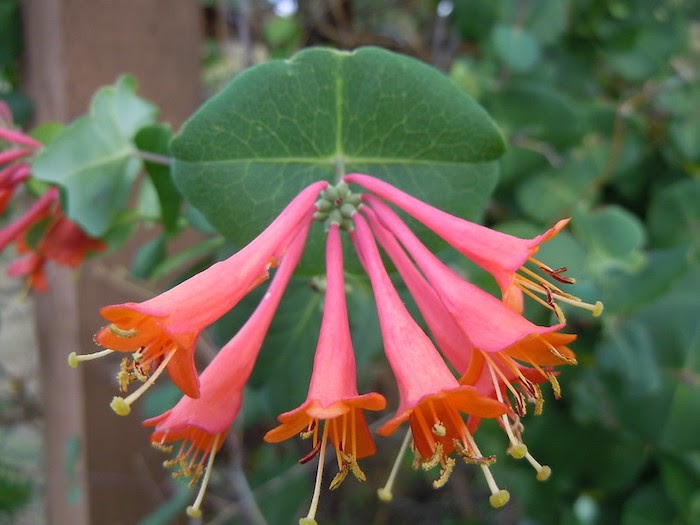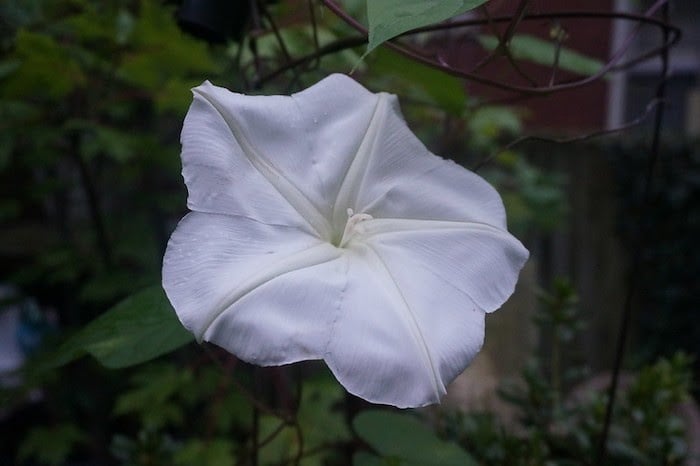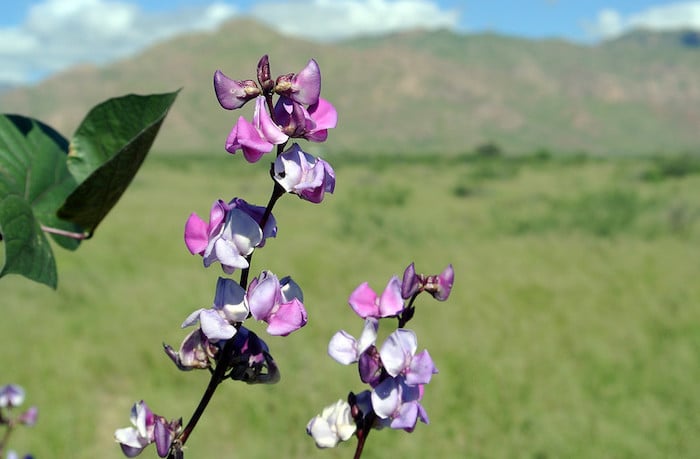
Perennials in the flower beds? Check. Annuals in ceramic pots? Check. A backyard trellis tunnel of white roses, hydrangea climbing up the walls, and wisteria twisting around the pergola? Let’s add flowering vines to the list.
Climbing vines will grow up almost any structure in the yard, including trellises, fences, gates, and arbors. Their rapid growth and fragrant flowers will create a stunning landscape centerpiece, protective privacy screen, or even a grand entryway.
If you want your landscape to make a showy impression, check out our list of 20 flowering vines for your yard. Flower beds and potted plants won’t always do the trick. But a trellis of climbing honeysuckle vine, passion flower, or sweet pea? Now that will make the neighbors wish they had your lawn.
- 20 Flowering Vines for Your Yard
- 1. Clematis
- 2. Climbing Hydrangea
- 3. Trumpet Honeysuckle
- 4. Wisteria
- 5. Climbing Rose
- 6. Passion Flower Vine
- 7. Sweet Pea
- 8. Trumpet Vine
- 9. Morning Glory
- 10. Black-Eyed Susan Vine
- 11. Mandevilla
- 12. Star Jasmine
- 13. Bougainvillea
- 14. Moonflower
- 15. Sky Vine
- 16. Cypress Vine
- 17. Climbing Nasturtium
- 18. Chocolate Vine
- 19. Hyacinth Bean
- 20. Carolina Jessamine
- How to Pick the Right Flowering Vines for Your Yard
- FAQ About Flowering Vines
20 Flowering Vines for Your Yard
1. Clematis

Clematises are perennial vines and vigorous climbers that will turn any trellis, fence, or arbor into a showpiece of purple flowers. Their star-like blooms offer a range of colors, and their roots like a bit of cool shade.
Before you plant, know that clematis is considered invasive (species that tend to spread aggressively and often harmfully) in many areas of the country.
Bloom time: Between spring and fall. Bloom time varies among species.
Shade or sun: Most species prefer full sun. Some may tolerate partial shade.
Color varieties: Blue, pink, purple, white, red, and yellow
Common names: Most species are known as clematis, but some species are known as old man’s beard, virgin’s bower, leather flower, vase vine, or traveler’s joy.
Hardiness zones: 3-9, depending on the species
Best time to plant: Fall or early spring
2. Climbing Hydrangea

You adore your blue and pink hydrangea shrubs, so you are sure to love these climbers as they reach heights up to 50 feet. Make sure your trellis structure has the strength to bear this flowering vine’s weight.
Bloom time: Late spring and summer
Shade or sun: Full sun to part shade
Color varieties: White and pink
Common names: Climbing hydrangea
Hardiness zones: 5-7
Best time to plant: Spring or fall
3. Trumpet Honeysuckle

Trumpet honeysuckle are showy flowers perfect for a spot of color in your landscape. As these vines twist and climb through your fence or trellis structure, they may reach lengths up to 15 feet long.
Bloom time: Late spring and summer
Shade or sun: Prefers full sun but can tolerate some shade
Color varieties: Blooms are red and yellow
Common names: Coral honeysuckle and scarlet honeysuckle
Hardiness zones: 4-9
Best time to plant: Spring
4. Wisteria

Wisteria is an overhanging bloomer that will look like a soft blanket over your pergola or other roof structures. Just remember to prune regularly to keep the fast-growing vine contained as it is an invasive species.
Bloom time: Late spring and early summer
Shade or sun: Full sun
Color varieties: White, lavender, lilac, pink, and purple
Common names: Varieties include Chinese, Japanese, and American wisteria vines
Hardiness zones: 4-9, depending on the variety
Best time to plant: Spring and fall
5. Climbing Rose

And you thought a couple of rose bushes was enough to make your backyard a romantic garden. Nothing’s more enchanting than an entire trellis tunnel of climbing roses. But be careful — these climbing plants are very invasive.
Bloom time: Late spring and early summer
Shade or sun: Prefers full sun but will tolerate light shade
Color varieties: Red, white, bright pink, pale pink, yellow-orange, and yellow
Common names: Climbing rose
Hardiness zones: Depending on the variety, 4-9
Best time to plant: Early spring
6. Passion Flower Vine

It may not look like it, but this really is a flower! The passion flower is likely one of the showiest blooms you can grow in the garden, especially as its flowering vines reach heights up to 20 feet tall.
Bloom time: Summer until fall
Shade or sun: Full sun to partial shade
Color varieties: Purple, red, orange, pink, blue, and yellow
Common names: Passion flower and passion vine
Hardiness zones: 5-11
Best time to plant: Spring
7. Sweet Pea

Sweet pea is the perfect flowering perennial or annual vine to grow for clusters of cheerful, vibrant color. Their ornamental petals put on a show for a long blooming season and will make a lovely accent to your she shed or cottage garden. Just beware, while this isn’t invasive, it can overcrowd other plants in the area.
Bloom time: Bloom time depends on location. If you live in an area with cooler summer temperatures, expect them to bloom in late spring through fall. Gardeners growing sweet pea in warmer regions can expect blooms in winter and early spring.
Shade or sun: Full sun to partial shade
Color varieties: Pink, white, purple, peach, red, orange, and blue
Common names: Sweet pea
Hardiness zones: 2-11
Best time to plant: If you’re gardening in a region with cooler summers, plant sweet pea in early spring, or begin growing sweet pea indoors four weeks before the last expected spring frost. If you live in a region with hot summers, plant your sweet peas in early fall.
8. Trumpet Vine

If hummingbirds aren’t visiting your gardens, entice them with the trumpet vine’s tubular flowers. Keep in mind that these flowering vines have invasive qualities, making them much more enjoyable when maintained.
Bloom time: Summer through early fall
Shade or sun: Prefer full sun but can tolerate some shade
Color varieties: Yellow, orange, and red
Common names: Trumpet creeper, hummingbird vine, and cow itch vine
Hardiness zones: 4-9
Best time to plant: Spring or fall
9. Morning Glory

Morning glory will attract butterflies and hummingbirds to your garden all day long. This vining flower is the common name for over 1,000 flowering plant species. You’re almost guaranteed to find a morning glory type that suits your tastes –– and the pollinators’!
Keep in mind, this beautiful annual vine with its heart-shaped leaves and trumpet-shaped flowers can become invasive if let out of control.
Bloom time: Late summer and fall
Shade or sun: Full sun
Color varieties: Purple, red, blue, white, bright pink, and light pink. Rare morning glory varieties range between yellow and orange.
Common names: Morning glory or morning-glory
Hardiness zones: 3-10
Best time to plant: Late spring or early summer
10. Black-Eyed Susan Vine

The black-eyed Susan vine features five overlapping petals. Sometimes these detailed petals even bloom in mixed colors of pinks, oranges, and yellows, creating a beautiful sunset effect.
Despite the shared name, the black-eyed Susan vine and black-eyed Susan (Rudbeckia hirta) are not related. Be careful with this vine because it is considered an invasive species (nonnative species that has the potential to harm native ecosystems) in Hawaii and Mexico.
Bloom time: Summer to fall
Shade or sun: Full sun to partial shade
Color varieties: Red, yellow, orange, white, and pink
Common names: Black-eyed Susan vine
Hardiness zones: 10 and 11
Best time to plant: Spring
11. Mandevilla

Mandevilla’s vibrant flowering vines will go great with your new planter box or container garden. Better yet, Mandevilla will double as a houseplant when cold winter arrives. These vines, coming from Central and South America, are not an invasive species but can overcrowd other plants in the garden if not cut back.
Bloom time: Early summer through first fall frost
Shade or sun: Full sun to partial shade
Color varieties: White, red, pale apricot, and several shades of pink
Common names: Rocktrumpet
Hardiness zones: 9-11
Best time to plant: Plant your Mandevilla outdoors when warmer temperatures arrive. The daytime temperature shouldn’t fall below 60 degrees, and nights shouldn’t fall below 50 degrees.
12. Star Jasmine

Decorate your landscape with star jasmine’s small white pinwheels. While star jasmine may take some time to establish, patient gardeners reap the rewards. These fragrant blooms will look stunning along an arched trellis and will even attract helpful bees. Jasmine is also a good choice if you’re looking for more privacy in your yard.
Bloom time: Spring or early summer
Shade or sun: Prefers full sun but has a high shade tolerance
Color varieties: White
Common names: Confederate jasmine
Hardiness zones: 8-11
Best time to plant: Any time of year
13. Bougainvillea

You’ll be tempted to pick bougainvillea’s frilly blooms, but watch out for those fingers. This plant has thorny vines and may have you grabbing a Band-Aid instead.
The bougainvillea vine doesn’t produce the colorful flowers that make bougainvillea so popular. Instead, it blooms tiny white flowers, which appear right in the center of brightly colored leaves called bracts, often mistaken as flowers.
Bloom time: Spring
Shade or sun: Full sun
Color varieties: Pink, purple, white, yellow, and orange
Common names: Paperflower
Hardiness zones: 9-11
Best time to plant: Spring or early summer
14. Moonflower

The moonflower is a close relative of the sweet potato vine and is in the same family as morning glory. If you’ve been looking for a white, fragrant, night-blooming flower for your moon garden, this may be the one.
Bloom time: Summer
Shade or sun: Full sun
Color varieties: White
Common names: Tropical white morning glory and moon vine
Hardiness zones: 10 and 11
Best time to plant: Spring. In colder climates, begin growing indoors in late winter.
15. Sky Vine

Sky vine produces ruffled blossoms with colors mixing between blue and violet, contrasted with yellow throats. In tropical climates, the sky vine will flourish and bloom almost all year round. Just watch for this plant over the years, as it is currently listed as invasive in Hawaii.
Bloom time: Late summer through fall
Shade or sun: Full sun to partial shade
Color varieties: Lavender-blue
Common names: Bengal trumpet, Bengal clockvine, blue Thunbergia, blue skyflower, blue trumpet vine, clockvine, skyflower, and skyvine
Hardiness zones: 8-11
Best time to plant: Grow indoors six weeks before the last expected spring frost date.
16. Cypress Vine

Cypress vine is a member of the morning glory family. It’s bound to attract a few hummingbirds or transform an old fence. It’ll even keep you on your toes –– ignore its maintenance needs for too long, and it may begin growing invasively in garden spaces you wanted to keep off-limits.
Bloom time: Summer through fall
Shade or sun: Prefers full sun but can tolerate light shade
Color varieties: Red, pink, and white
Common names: Cypressvine morning glory, cardinal vine, cardinal creeper, star glory, and hummingbird vine
Hardiness zones: 6-11
Best time to plant: Spring
17. Climbing Nasturtium

For a peppery salad that packs a punch, sprinkle in a few bright nasturtium flowers or leaves. The vibrant petals will bring your green salad (and your food photos for Instagram) to the next level.
While climbing nasturtium is considered invasive in some southeastern states, these flowering vines are perfect for first-time gardeners or gardeners who prefer low-maintenance plants. Nasturtium plants prefer neglect and grow better in poor soils without fertilizer. A rich, fertile soil could leave you with minimal blooms.
Bloom time: Summer through fall
Shade or sun: Prefers full sun but can tolerate light shade
Color varieties: Red, yellow, orange, and white
Common names: Climbing nasturtium
Hardiness zones: 8-11, depending on the variety
Best time to plant: Spring
18. Chocolate Vine

Chocolate vines can reach up to 30 feet tall and show off purple-chocolate flowers with a rich, vanilla scent. You may even get a whiff of chocolate in there, too. Keep in mind this vine is considered invasive in 16 states.
Bloom time: Spring and summer
Shade or sun: Prefers partial shade but can tolerate full sun
Color varieties: Chocolate-purple
Common names: Five-leaf akebia or five-leaf chocolate vine
Hardiness zones: 4-9
Best time to plant: Spring
19. Hyacinth Bean

If you’re looking for flowering vines that bloom all summer, look no further than hyacinths. Hyacinth bean features pinkish-purple blossoms and reddish-purple pods. The pods look similar to lima bean pods but are best left for decorative value. You have to cook the beans a certain way if you want them to be safe for eating.
Bloom time: Summer through fall
Shade or sun: Full sun
Color varieties: White, purple, and pink
Common names: Lablab-bean, bonavist bean or pea, seim bean, dolichos bean, Egyptian kidney bean, bataw, Indian bean, and Australian pea
Hardiness zones: 10 and 11
Best time to plant: Spring, after the threat of frost has passed
20. Carolina Jessamine

For a flush of sunshine during the chilly months, grow Carolina jessamine along your fence, pergola, or garden gate. We often think flowers only bloom during warm spring and summer, but winter flowers like to make their appearance, too.
Carolina jessamine can be found natively throughout the southern states and as far north as Virginia. They are perfect if you’re looking for a native species with few disease or insect problems.
Note: Carolina jessamine is highly poisonous to humans.
Bloom time: Late winter to early spring
Shade or sun: Prefers full sun but can tolerate partial shade
Color varieties: Yellow
Common names: Yellow jessamine, yellow jasmine, Carolina jasmine, woodbine, evening trumpet flower, poor man’s rope, and gelsemium
Hardiness zones: 7-10
Best time to plant: Late winter
How to Pick the Right Flowering Vines for Your Yard
Not every flowering vine on this list is suitable for your yard, but many likely are. It’s essential to know your USDA plant hardiness zone so you can best determine which vine of flowers will flourish in your region’s climate. Color varieties are also useful to consider, as you’ll want a flowering vine that accentuates the existing landscape.
Flowering vines are an asset to any landscape. They can give a fresh, colorful look to a rusty garden gate or even cover up the blemish on the side of the house. Their twisting blossoms and dense cover make for a beautiful display. And with the proper maintenance and care, you’ll get to look forward to these vine flowers year after year.
FAQ About Flowering Vines
Wisteria is one of the best choices if you want a fast-growing flowering vine. Where you live and your climate will ultimately decide what grows best in your environment, but typically, wisteria is the fast option. There are other options if your main goal is speed:
● Clematis
● Climbing hydrangea
● Star jasmine
Clematis and sweet pea are great options with long bloom periods. Specific bloom times usually depend on the variety of vine.
● Clematis: For flowering vines that bloom all summer, go with clematis. You can expect clematis to bloom between spring and fall.
● Sweet pea: While sweet peas aren’t flowering vines that bloom all year, they do have specific bloom times depending on where they are. In warmer climates, expect sweet peas to bloom in winter and early spring. For areas with cooler summer temperatures, expect blooms in late spring through fall.
The easiest flowering vine to grow is climbing nasturtium. This low-maintenance plant thrives in poor soils and grows better without fertilization. For those gardeners that sometimes forget about their plants, this is a perfect vine that prefers neglect over care.
When to Call a Professional Landscaper
Sometimes these flowering vines need a bit of training before they can begin twining up their host structure. And a few species will even escape from you and establish themselves as a weed.
To help grow these vines successfully and without any invasive weed worries, call a landscape professional near you.
Working with a landscape professional will help ensure proper maintenance is in place, your vines can grow up with ease, and your vines’ seeds are safely planted into the ground.
Main Photo Credit: Pixabay